There were 197 posts tagged:
Plantronics Savi 8220 is 1st Wireless ANC Designed for Desk Phones
 Noisy open offices can lead to unproductive and stressed-out employees ... and, unfortunately, this work environment is prevalent. Organizations should look to headsets as tools to bridge the gap and increase productivity in the workplace. Headsets must meet the needs of employees (who need headsets that are comfortable, convenient, and cancel background noise) and their customers (who need clear conversations, every time they call) to achieve organizational goals.
Noisy open offices can lead to unproductive and stressed-out employees ... and, unfortunately, this work environment is prevalent. Organizations should look to headsets as tools to bridge the gap and increase productivity in the workplace. Headsets must meet the needs of employees (who need headsets that are comfortable, convenient, and cancel background noise) and their customers (who need clear conversations, every time they call) to achieve organizational goals.Plantronics' newest DECT wireless headset series, the Savi 8200, has been built for the human experience. The Savi 8220 features active noise canceling (ANC) that blocks out background noise so you can always stay focused on what’s important. This is the first headset on the market that's designed with ANC for desk phones! And, to further enhance collaboration and communication, these headsets also connect to PCs and mobile phones/tablets. Count on Plantronics technology for rich, people-first collaboration experiences so good that ideas can be shared and heard—wherever, whenever and however they happen.
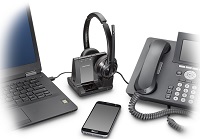 With the noise-canceling mic, you’ll sound your best even in noisy environments. For the most sensitive environments, you can turn up noise canceling with the close conversation limiting feature (configurable in Plantronics Hub, free download here) for additional privacy. The mic boom is flexible, allowing for optimal placement: two finger widths away from the corner of the user's mouth.
With the noise-canceling mic, you’ll sound your best even in noisy environments. For the most sensitive environments, you can turn up noise canceling with the close conversation limiting feature (configurable in Plantronics Hub, free download here) for additional privacy. The mic boom is flexible, allowing for optimal placement: two finger widths away from the corner of the user's mouth.Top Features of the Savi 8220:
*Active Noise Canceling*UC and Microsoft certified versions
*Conference up to 4 headsets to 1 base unit - great for training in contact centers and also conference calls
*Connect 2 devices together, for conferencing between PC to desk phone; or mobile phone to PC
*13 hours of talk time!
*Ringer on the base (can be disabled, if needed)
*Large leatherette ear cushions and padded leatherette headband
*Roam up to 590 feet away from the base (this depends upon physical environment)
*DECT Security certified: uses the latest standards in DECT wireless security
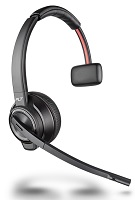
The Savi 8200 also comes in a single-ear variant, which does not have ANC. And, just like the Savi 8220 headsets, the Savi 8210 comes in UC and Microsoft versions for every user environment.
Is it time to reassess headsets at your organization? Are you looking for high quality professional headsets with superior sound?
Take a look at the Plantronics Savi 8200 headsets, and call one of our headset experts today: 1-866-998-9991.Is Excessive Sitting the New Health Epidemic?
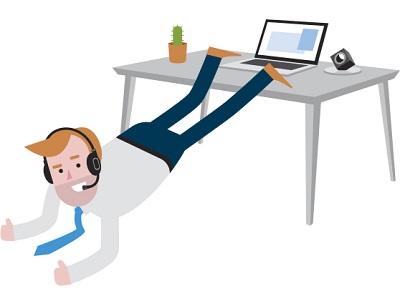
It’s a scientific fact that leading a sedentary lifestyle can be harmful to one’s health.
The job category of “knowledge worker” – people who handle information as their job – can be considered sedentary, where employees remain seated and desk-bound for 8 or more hours each day. This does not include their commute time to the job … which could be an hour or more each way. Your job (and the time it takes to get there) just may be harming you!
What are the harmful effects of inactivity?
According to an article on the Australian government health department web site, some hazards associated with sitting all day include:
- Weakened legs and gluteals, which could lead to falls, and strains when exercising
- Weight gain
- Hips and back – hip flexor muscles shortened, leading to problems in hip joints; sitting for extended periods of time can cause problems in your back, especially if you have poor posture
- Anxiety and depression
- Cancer, heart disease, diabetes
- Varicose veins, Deep vein thrombosis
- Stiff neck and shoulders
The current official U.S.-government issued Physical Activity Guidelines, in place since 2008, says that adults (classified as ages 18-64) who are physically active are less likely to develop chronic diseases than adults who aren’t active – regardless of gender or ethnicity. The Office of Disease Prevention and Health Promotion reports that the worst thing to do is to avoid activity – any physical activity is better than none, and has health benefits.
Aerobic activity is best for substantial health benefits. Each week, strive for at least 150 minutes (2 hours, 30 minutes) of moderate-intensity aerobic physical activity (brisk walking, ballroom dancing, doubles tennis, water aerobics); or, 75 minutes (1 hour, 15 minutes) of vigorous-intensity aerobic physical activity (jogging, singles tennis, jumping rope, aerobic dancing or swimming laps); or a combination of these activities. Doing more than these recommended amounts each week leads to even greater health benefits.
At least twice a week, muscle-strengthening activities that are moderate or high intensity and involve all major muscle groups should be completed. This is defined as lifting weights or using resistance bands. Why is strength training recommended? It protects bone health and muscle mass, makes you stronger and fitter, keeps weight off for good, burns more calories, and helps with balance, coordination and posture — to name a few of the benefits.
New government guidelines are expected to be published by the end of 2018.
Of course, these activities will happen either before or after work; however, it is still possible to incorporate physical activity into even the most sedentary of desk jobs.
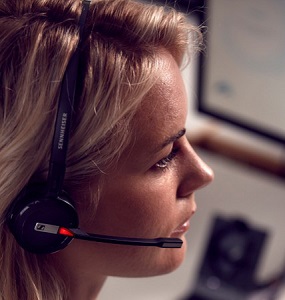 Tips to Keep Your Office in Shape:
Tips to Keep Your Office in Shape:* Take the stairs instead of the elevator
* Walk over and talk to co-workers, rather than sending an email
* Exercise on your lunch break
* Organize “walking meetings”
* Use a wireless headset and walk around the office while on calls
* Park your car in a far away spot to get extra steps to the building; or, ride your bike or walk to work.
Enjoy this quick Sennheiser video about how to get your office in shape (we particularly like the chair lifts!)
Get moving on your job today – even if you are one of the approximately 86 percent of the U.S. workers who sit all day – be creative and find ways to incorporate movement in your daily routine.
Sources:
Victoria State Government Better Health Channel: The dangers of sitting: why sitting is the new smoking
ODPHP: Guidelines for Adult Activity
U.S. News and World Report: Are you suffering from sitting disease?
Everyday Health: 7 Ways Strength Training Boosts Your Health and Fitness
Sennheiser SDW 5016, 5015 are Wireless Headsets for the Modern Office
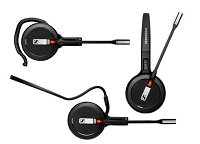 Sennheiser office and contact center headsets are high quality products with premium sound, and the new SDW 5000 DECT wireless series is no exception.
Sennheiser office and contact center headsets are high quality products with premium sound, and the new SDW 5000 DECT wireless series is no exception. 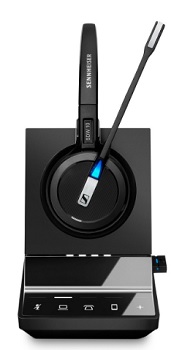 Sennheiser positions the SDW series as future-proof devices with flexibility for modern office professionals in modern work environments.
Sennheiser positions the SDW series as future-proof devices with flexibility for modern office professionals in modern work environments.Density and advanced security are the hallmarks of the series; a high density wide band mode assures excellent sound is possible in high density environments and the protected pairing, 128-bit authentication and DECT security certification keep conversations confidential.
Choose between the SDW 5015 for desk phone and computer or the SDW 5016 for desk phone, computer, and smartphone/tablet.
Product highlights:
Remarkable noise-canceling mic: In our testing of the SDW 5016 (MSRP: $409.00), we were amazed at the exceptional noise canceling in the microphone. We walked through our noisy warehouse with the normal background sounds of people speaking and a cart being pushed and loaded with products among the shelves, and the noise was not transmitted to the person on the other end of the call. This is because of the headset's two-mic design and cutting edge voice-detection technology. If you work in a noisy office, this is the perfect headset.Warranty: Sennheiser wireless headsets are covered by a 2-year warranty, double the industry standard.
Videos: Sennheiser has produced a series of short YouTube videos that cover everything from how to assemble and wear the 3 included wearing styles* (headband, neck band, and ear hook), to how to handle, conference, and transfer calls. Another video highlights the different
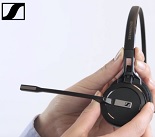 devices (USB and Bluetooth headsets and speakerphones) that can be connected to the SDW 5000 base. These videos are invaluable resources for SDW 5000 series headset wearers, who should bookmark the page for easy access: SDW 5000 Series Playlist.
devices (USB and Bluetooth headsets and speakerphones) that can be connected to the SDW 5000 base. These videos are invaluable resources for SDW 5000 series headset wearers, who should bookmark the page for easy access: SDW 5000 Series Playlist.Free software for headset updates: HeadSetup Pro is the must-have companion software for all of your Sennheiser devices. The FREE software download is compatible with Windows operating systems. Download the software now: HeadSetup Pro.
Sennheiser included a built-in triangular busy light on the mic boom that turns Red when busy; Purple when streaming music; and Blue when the headset is docked on the base.
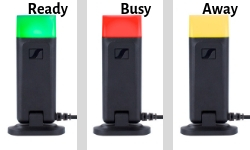 New to the Sennheiser product line is a Busylight designed for the SDW series. Connect it to the Busylight port (marked in blue) at the back of any of the SDW base units, and your presence is immediately indentified as Red (Busy), Green (Available), or Yellow (Away). It can be attached to a computer monitor, or placed on a desk. It is UC and Skype for Business certified.
New to the Sennheiser product line is a Busylight designed for the SDW series. Connect it to the Busylight port (marked in blue) at the back of any of the SDW base units, and your presence is immediately indentified as Red (Busy), Green (Available), or Yellow (Away). It can be attached to a computer monitor, or placed on a desk. It is UC and Skype for Business certified.Ready to learn more about Sennheiser SDW 5000 headsets? Give us a call at 1-866-998-9991 and talk to one of our headset experts today!
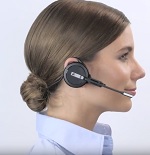
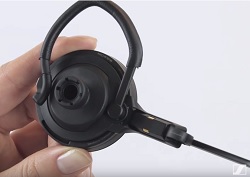 *SDW 5015 comes with the ear hook and headband only; the neck band is an optional, additional purchase.
*SDW 5015 comes with the ear hook and headband only; the neck band is an optional, additional purchase.Employers, Take Note! New Study Finds that Noisy Offices Cause Turnover
Do you work in an office where noise levels are similar to those in a crowded football stadium? From colleagues' reality TV discussions to personal phone calls and work-related chatter, noise is all too common in the pervasive open office plan. The open office was designed for collaboration, breaking down walls that could be barriers to information sharing. The unforseen consequences of this office design: a lack of privacy in a noisy, distracting environment.
Did you know that each distraction takes 23 minutes to recover from? This translates into thousands of lost hours each year at organizations, at a significant and costly impact.
In a new study commissioned by Plantronics, Oxford Economics found that 63 percent of employees say they lack quiet space for focused work, which has a negative effect on their productivity, satisfaction and well-being.
Other findings:
•Only 1 percent of employees say they can block out distractions in the office, without taking extra steps. This is a dramatic decline since this study was last done, in 2015; at that time, 20 percent of employees reported that they could block out distractions.
•96 percent of executives see employee productivity as critical to their financial performance, yet just 40 percent understand the link between noise, distraction and productivity.
•A mere 6 percent of executives report having equipped their office with noise mitigating features.
•Employees in the noisiest office environments are more likely to say they may leave their job in the next six months.
The open office plan is so pervasive that epidemic noise levels have now been reached worldwide, but is anyone paying attention? Executives, this is your wake-up call! It's time to fix the problem.
Contact us to learn how to navigate in noisy office environments (Here's a hint: headsets!).

Did you know that each distraction takes 23 minutes to recover from? This translates into thousands of lost hours each year at organizations, at a significant and costly impact.
In a new study commissioned by Plantronics, Oxford Economics found that 63 percent of employees say they lack quiet space for focused work, which has a negative effect on their productivity, satisfaction and well-being.
Other findings:
•Only 1 percent of employees say they can block out distractions in the office, without taking extra steps. This is a dramatic decline since this study was last done, in 2015; at that time, 20 percent of employees reported that they could block out distractions.
•96 percent of executives see employee productivity as critical to their financial performance, yet just 40 percent understand the link between noise, distraction and productivity.
•A mere 6 percent of executives report having equipped their office with noise mitigating features.
•Employees in the noisiest office environments are more likely to say they may leave their job in the next six months.
The open office plan is so pervasive that epidemic noise levels have now been reached worldwide, but is anyone paying attention? Executives, this is your wake-up call! It's time to fix the problem.
Contact us to learn how to navigate in noisy office environments (Here's a hint: headsets!).
To Serve and Protect: Top-Level DECT Security Found in Jabra Engage Headsets
Cybercrime and the theft of personal data is on the rise, and Jabra has risen to the challenge and built its newest DECT wireless headsets, the Engage series, with the wireless connection secured using 256-bit AES encryption, giving a line of defense that goes beyond that of DECT Security Level C.
 Now you may be saying: "WAIT! WHOA! HOLD UP! Wireless headsets can cause a potential security breach?" The average person would not be able to "hack" into any wireless calls without having a pretty specific skill set; however, identity theft is a real concern for businesses handling personal data and sensitive conversations. Customers put their trust in the companies they choose to do business with, and the company must protect its customers with a proactive security culture.
Now you may be saying: "WAIT! WHOA! HOLD UP! Wireless headsets can cause a potential security breach?" The average person would not be able to "hack" into any wireless calls without having a pretty specific skill set; however, identity theft is a real concern for businesses handling personal data and sensitive conversations. Customers put their trust in the companies they choose to do business with, and the company must protect its customers with a proactive security culture.
The Jabra Engage has increased security of the wireless connection between the wireless headset and its base unit, and the rock-solid security is provided in 3 steps, which improve the protection of calls to a category-leading level.
Step 1: Pairing. This first step is a physical bonding of the base unit and headset. Jabra has patented "physical assisted pairing" to increase security. The Jabra assisted pairing method occurs only when the headset is docked in the base unit, and a secret link-key is then formed when the two pair. Wireless connection is secured with patented pairing; authentication between headset and base is established with 128-bit level technology compared to the category-standard 64-bit.
Step 2: Authentication. At the start of a call, encryption is used to set up secure authentication between the Engage headset and its base. A link is established using a secret key-link formed in the pairing (without this, the headset and base unit will not work together).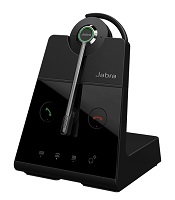 This means that a "non-paired" headset cannot be used with the base unit. The authentication link is also protected by encryption. The better the encryption level, the more secure the established link.
This means that a "non-paired" headset cannot be used with the base unit. The authentication link is also protected by encryption. The better the encryption level, the more secure the established link.
Step 3: Encryption. During calls, the audio signal between base unit and headset transports data, which is secured via encryption. The higher encryption level, the better the protection of data. With Jabra Engage, the encryption link is renewed every minute to make decryption more difficult.
Security algorithms are listed in FIPS 140-2 standards required by the U.S. military and government, and recommended by the National Institute of Standards and Technology for financial institutions who demand the highest degree of security.
In addition, the Engage series enables 3 times as many people to work wirelessly in the same space, which is why Jabra says it was engineered as the world's most powerful professional wireless headset.
To learn more about the Jabra Engage series, contact our team of headset experts today: 1-866-998-9991.
 Now you may be saying: "WAIT! WHOA! HOLD UP! Wireless headsets can cause a potential security breach?" The average person would not be able to "hack" into any wireless calls without having a pretty specific skill set; however, identity theft is a real concern for businesses handling personal data and sensitive conversations. Customers put their trust in the companies they choose to do business with, and the company must protect its customers with a proactive security culture.
Now you may be saying: "WAIT! WHOA! HOLD UP! Wireless headsets can cause a potential security breach?" The average person would not be able to "hack" into any wireless calls without having a pretty specific skill set; however, identity theft is a real concern for businesses handling personal data and sensitive conversations. Customers put their trust in the companies they choose to do business with, and the company must protect its customers with a proactive security culture.The Jabra Engage has increased security of the wireless connection between the wireless headset and its base unit, and the rock-solid security is provided in 3 steps, which improve the protection of calls to a category-leading level.
Step 1: Pairing. This first step is a physical bonding of the base unit and headset. Jabra has patented "physical assisted pairing" to increase security. The Jabra assisted pairing method occurs only when the headset is docked in the base unit, and a secret link-key is then formed when the two pair. Wireless connection is secured with patented pairing; authentication between headset and base is established with 128-bit level technology compared to the category-standard 64-bit.
Step 2: Authentication. At the start of a call, encryption is used to set up secure authentication between the Engage headset and its base. A link is established using a secret key-link formed in the pairing (without this, the headset and base unit will not work together).
 This means that a "non-paired" headset cannot be used with the base unit. The authentication link is also protected by encryption. The better the encryption level, the more secure the established link.
This means that a "non-paired" headset cannot be used with the base unit. The authentication link is also protected by encryption. The better the encryption level, the more secure the established link.Step 3: Encryption. During calls, the audio signal between base unit and headset transports data, which is secured via encryption. The higher encryption level, the better the protection of data. With Jabra Engage, the encryption link is renewed every minute to make decryption more difficult.
Security algorithms are listed in FIPS 140-2 standards required by the U.S. military and government, and recommended by the National Institute of Standards and Technology for financial institutions who demand the highest degree of security.
In addition, the Engage series enables 3 times as many people to work wirelessly in the same space, which is why Jabra says it was engineered as the world's most powerful professional wireless headset.
To learn more about the Jabra Engage series, contact our team of headset experts today: 1-866-998-9991.

